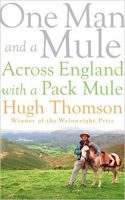One Man and a Mule: Across England with a Pack Mule
by Hugh Thomson
(Preface, £20)

Titles can be misleading. Just as Trainspotting wasn’t about anoraks on the platform, so One Man and a Mule isn’t about travelling solo with an animal from one side of the country to the other. For much of their 200-mile walk, east from St Bees to Robin Hood’s Bay, Hugh Thomson and his mule, Jethro, have human company. They also have a support vehicle.
Why the mule, given that the journey was supposedly inspired by Stevenson’s Travels with a Donkey in the Cévennes? Well, Thomson had used pack mules while researching his books on Peru (The White Rock and Cochineal Red) and fancied doing the same in a country where the practice had almost died out.
In Peru, though, he’d had muleteers to make the animals biddable. He needed some help. So he persuaded his friend and fellow travel writer Jasper Winn, a man who grew up with horses in Ireland and is the nearest thing he knows to a mule-whisperer, to join him.
A lippy 10-year-old, sizing up the threesome on the Yorkshire Moors, tells them: “So what you’re doing is ‘olden-days style’?” Well, yes and no. Muleteering in the North of England isn’t as straightforward as it used to be.
Finding a mule — in this case at an RSPCA rescue centre — is only the start of it. A mule can’t stop and crop where he fancies, and neither can his masters. Pasture and billets have to be arranged in advance, and a five-and-a-half-ton Dodge horse van is needed to transport Jethro from the evening’s stopping point to his night-time quarters and back again in the morning.
Jethro, while too small to be ridden, is too heavy to be hoisted over the stiles that appear when a bridleway turns suddenly into a footpath. He’s not exactly a worker, either. While Thomson and Winn are coaxing him out of the Dodge in the Lake District, a girl of about nine, watching the proceedings, says of the mule’s saddlebags: “They look almost empty. And your backpacks look quite full.”
The mule, then, is less of a beast of burden than a creaturely contrivance. He is, though, a good conversation piece. And it’s conversations that Thomson is intent on as he makes his way from the Lake District through the Dales to the Yorkshire Moors, chatting to farmers and b&b owners, fell runners and cyclists about everything from Quakerism (the movement was founded in Sedbergh, Cumbria) to Brexit. He is, in his own characterisation, “a soft southerner” getting a feel for the North. Join him — and Jasper and Jethro — and you’ll be in entertaining company.
Thomson times his arrival in Whitby, the town Bram Stoker used as the English setting for Dracula, to coincide with the Hallowe’en Goth Festival. There he delivers the best joke about grammar I’ve read in a long time:
“Two teenage girls broke the silence. They were dressed in startling symmetry: one in white leather jacket with black trousers, the other in black leather with white trousers. Both had red lipstick that could have stopped traffic at 50 yards.
‘I just wanna tell her to fucking man up,’ said one, loudly.
I winced, as did the Count Dracula lookalike opposite me on the bench. It is always painful when the young use a split infinitive.” MK
